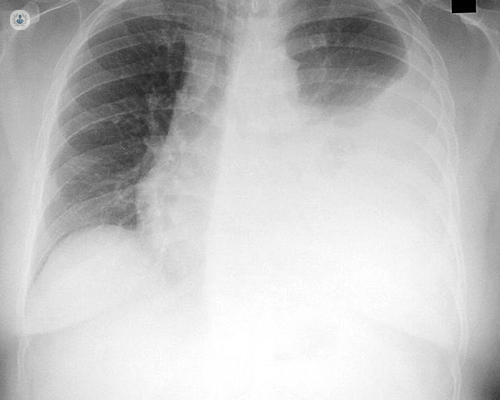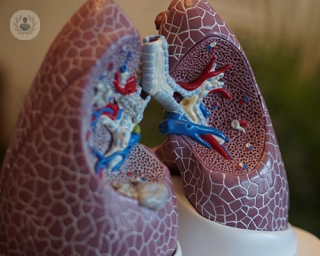Pleural effusion
Ms Emma Beddow - Cardiothoracic surgery
Created on: 11-13-2012
Updated on: 07-31-2023
Edited by: Lauren Dempsey
What is pleural effusion?
Around the lungs, there is a thin membrane called the pleural. Usually, there is a small amount of fluid in this space but if excess fluid builds up, this is known as pleural effusion. It is also referred to as ‘water on the lungs.’ It limits the space the lungs can expand into while breathing in, forcing the patient to take shallow breaths.

What are the different types of pleural effusion?
Pleural effusion is divided into two types:
Transudative
The excess fluid is similar to normal pleural fluid and rarely needs to be treated unless there is a very high amount. It is usually caused by congestive heart failure.
Exudative
Proteins, blood, inflammatory cells and even bacteria may leak along with fluid from damaged blood cells into the pleural space. It may cause inflammation or other problems. This type can be caused by lung cancer and pneumonia.
What causes pleural effusion?
Pleural effusion can be caused by a wide range of things:
- Fluid from nearby organs: fluid can leak from other organs and become trapped in the pleural cavity. Conditions such as congestive heart failure (in which the heart doesn’t pump blood around the body properly), liver disease, and kidney disease can all lead to this.
- Cancer: typically, lung cancer, but metastases of other cancers can come at the lung too.
- Infections: tuberculosis, pneumonia, etc.
- Pulmonary embolism
- Autoimmune conditions: lupus, rheumatoid arthritis
- Complication of surgery
What are the symptoms of pleural effusion?
Common symptoms of pleural effusion include:
- chest pain
- dry coughing
- breathing problems or difficulties
- fever
Some patients may be asymptomatic and the fluid might be found during investigation for another reason.
How is pleural effusion diagnosed?
A number of tests can be performed to diagnose pleural effusion, such as:
- chest x-rays
- CT scan of the chest
- ultrasound of the chest
Will a pleural effusion go away on its own?
If the pleural effusion is not causing any problems or there isn't too much liquid, it may not require treatment. In cases of minor pleural effusion, it will usually clear up by itself.
How is pleural effusion treated?
If there is a large amount of fluid built up and/or causing problematic symptoms, the fluid can be drained, either by a needle (thoracentesis), by a tube inserted into a hole the doctor has made in the patient’s chest wall (tube thoracostomy), or by a long-term catheter if the patient suffers recurrent pleural effusions, so that they can be drained when they occur.
In some cases, surgical intervention may be necessary to deal with inflammation or unhealthy tissue in the pleural cavity.













